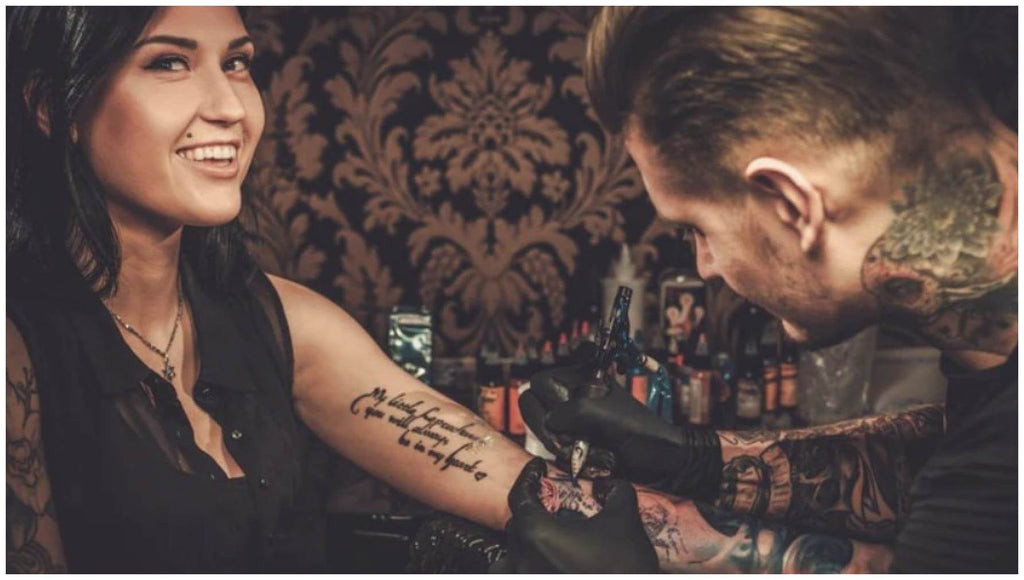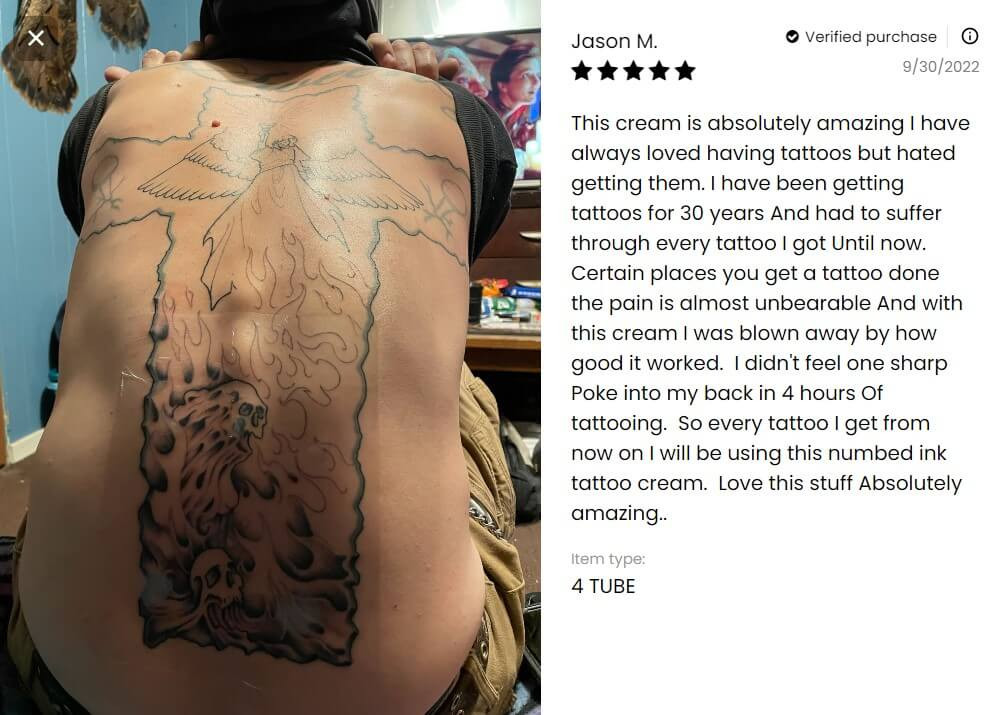Are you wondering if you can use numbing cream before getting a tattoo? Absolutely, at tattooat.com, we understand that managing pain is a key concern for many looking to get inked, and numbing creams can be a fantastic option to make the process more comfortable. They’re especially helpful for longer sessions or sensitive areas; they’re widely available and safe when used correctly, though it’s essential to discuss this with your tattoo artist beforehand to ensure a smooth and successful session. Explore tattoo preparation, pain management, and aftercare solutions all in one place.
1. Understanding Tattoo Numbing Cream
What Exactly Is Tattoo Numbing Cream?
Tattoo numbing cream is a topical anesthetic applied to the skin before a tattoo session to reduce pain. These creams generally last between 4-6 hours, giving you a comfortable window for your tattoo appointment. They contain active ingredients like lidocaine, which temporarily block nerve signals in the treated area.
There are a few main types of numbing creams:
- Nerve Deadeners: These contain lidocaine and temporarily numb the nerves in the skin, preventing them from registering pain.
- Nerve Blockers: These work similarly to nerve deadeners, using ingredients to block pain signals.
- Vasoconstrictors: These constrict blood vessels, which can reduce swelling and bleeding during the tattoo process, indirectly reducing pain.
 Tattoo artist applying numbing cream
Tattoo artist applying numbing cream
How Do Numbing Creams Work?
Numbing creams work by using active ingredients like lidocaine, prilocaine, or benzocaine. These substances interfere with the nerve signals being sent to the brain, effectively reducing or eliminating the sensation of pain in the applied area. Lidocaine, for instance, is a local anesthetic commonly used in minor medical procedures.
According to research, these creams work by temporarily deadening the nerves in your skin, which stops them from registering pain. Portland State University’s Art Department noted in July 2025 that the effectiveness of these creams depends on factors like skin type, pain tolerance, and the specific product used.
Are Numbing Creams Safe?
When used correctly, numbing creams are generally safe. However, there are potential risks:
- Allergic Reactions: Some individuals may be allergic to the ingredients in numbing creams. Always test a small area of skin before applying liberally.
- Over-Absorption: Applying too much cream or using it on broken skin can lead to over-absorption into the bloodstream, causing serious side effects like dizziness, seizures, or an irregular heartbeat.
- Skin Irritation: Numbing creams can sometimes cause redness, swelling, or itching at the application site.
To minimize risks, follow these guidelines:
- Consult with Your Artist: Discuss using numbing cream with your tattoo artist before your appointment.
- Follow Instructions: Carefully read and follow the product instructions.
- Apply Correctly: Apply a thin layer of cream to clean, unbroken skin.
- Monitor for Reactions: Watch for any signs of allergic reaction or skin irritation.
How Long Does Numbing Cream Last for Tattoos?
The duration of numbing cream’s effect varies, typically lasting between 4-6 hours. Factors influencing this include:
- Type of Cream: Different formulations have varying durations.
- Concentration of Active Ingredients: Higher concentrations may last longer.
- Individual Metabolism: How quickly your body processes the medication affects the duration.
- Application Technique: Applying the cream correctly can optimize its effectiveness and duration.
To maximize the numbing effect:
- Apply Generously: Use a sufficient amount of cream to cover the area.
- Occlusive Dressing: Cover the area with plastic wrap to enhance absorption.
- Timing: Apply the cream 60-90 minutes before your appointment to allow it to fully take effect.
2. Tattoo Artists and Numbing Cream: A Divided Opinion
Do Tattoo Artists Use Numbing Cream?
Tattoo artists have varying opinions on numbing cream. Many are happy to use it or allow clients to use it, while others are against it. Their reasons range from practical concerns to philosophical beliefs about the tattooing process.
Why Some Artists Like Numbing Cream
Artists who support numbing cream often do so for practical reasons:
- Efficiency: Numbing cream can help artists work more efficiently by reducing client movement and discomfort.
- Fewer Interruptions: Clients are less likely to need breaks, allowing the artist to focus and maintain a steady pace.
- Better Results: A still client leads to cleaner lines and better overall tattoo quality.
- Time-Saving: Numbing agents reduce the amount of time needed for a large piece. Rather than split a big upper thigh piece over 2-3 sessions, artists can do it all at once, freeing up time for other clients.
- Increased Scheduling: With fewer breaks and streamlined sessions, artists can schedule more clients over the course of the day.
Why Some Artists Dislike Numbing Cream
Some artists are against using numbing cream due to concerns about its effects on the skin and the tattooing process:
- Skin Texture: Numbing cream can alter the texture of the skin, making it more difficult to work with.
- Ink Absorption: Some artists believe that numbing cream affects how the skin absorbs ink, potentially leading to uneven healing.
- Tradition: Many artists feel that pain is an integral part of the tattoo experience.
- Medical Risks: Just as with any local anesthesia, there are medical risks. If applied incorrectly, the artist will have to spend extra time wiping away the excess cream, according to The Skin Museum.
- Exaggerated Pain: And with cheaper creams, some artists notice that the client experiences greater pain as the numbness starts to wear off. Because the client was expecting complete numbing, the pain is often exaggerated.
What Should You Do If You Want to Use Numbing Cream?
If you want to use numbing cream, the best approach is to:
- Communicate: Discuss your intention with your artist well in advance of your appointment.
- Ask Questions: Inquire about their experience with numbing cream and whether they have a preferred brand.
- Respect Their Decision: Be prepared to respect your artist’s decision if they are not comfortable working with numbing cream.
Jon Reiter, a veteran at Solid State Tattoos in Milwaukee, recommends that you notify your artists as soon as possible that you plan to use numbing cream. Otherwise you may face an awkward conversation when you show up with numbing cream that your artist didn’t know about.
And if you’re wondering if they can tell whether you used it or not, they can. Many creams have odors and they’ll be able to feel the texture difference on your skin.
 Numbed Ink cream review
Numbed Ink cream review
3. How to Choose the Right Numbing Cream
What to Look for in a Numbing Cream
Choosing the right numbing cream involves considering several factors:
- Ingredients: Look for creams with lidocaine, prilocaine, or benzocaine as active ingredients.
- Concentration: Higher concentrations (5% lidocaine is common) provide stronger numbing.
- Reviews: Read reviews to gauge the cream’s effectiveness and potential side effects.
- Brand Reputation: Choose reputable brands known for quality and safety.
Popular Numbing Cream Brands
Some popular and well-regarded numbing cream brands include:
| Brand | Active Ingredient | Concentration | Notable Features |
|---|---|---|---|
| Numbed Ink | Lidocaine | 5% | Specifically designed for tattoos; lasts 4-6 hours |
| Dr. Numb | Lidocaine | 5% | Popular choice for various procedures, including tattoos |
| Hush Anesthetic | Lidocaine | 4% | Contains botanical extracts to soothe skin; suitable for sensitive areas |
| Emla Cream | Lidocaine | 2.5% | Often recommended by doctors; requires a prescription in some countries |
| Uber Numb | Lidocaine | 5% | Maximum strength formula; fast-acting |
Prescription vs. Over-the-Counter Numbing Creams
Numbing creams are available in both prescription and over-the-counter (OTC) formulations:
- Prescription Creams: These typically contain higher concentrations of active ingredients and may require a consultation with a doctor. They are often more effective but also carry a higher risk of side effects.
- OTC Creams: These have lower concentrations and are readily available without a prescription. They are generally safer but may not be as effective for everyone.
According to a study by the American Academy of Dermatology, prescription numbing creams, such as those containing more than 5% lidocaine, should be used under medical supervision due to the potential for systemic absorption and adverse effects.
Ingredients to Avoid
When choosing a numbing cream, avoid products with:
- High Concentrations of Benzocaine: Benzocaine can cause methemoglobinemia, a serious condition that reduces the amount of oxygen in the blood.
- Artificial Dyes and Fragrances: These can irritate the skin and cause allergic reactions.
- Unnecessary Additives: Look for creams with minimal ingredients to reduce the risk of adverse reactions.
4. How to Use Numbing Cream Correctly for Tattoos
Step-by-Step Application Guide
To ensure the numbing cream works effectively and safely, follow these steps:
- Clean the Area: Wash the skin with soap and water and pat it dry.
- Apply a Thick Layer: Apply a generous amount of cream to the area to be tattooed.
- Cover with Occlusive Dressing: Wrap the area tightly with plastic wrap to enhance absorption.
- Wait: Leave the cream on for 60-90 minutes, or as directed by the product instructions.
- Remove and Clean: Remove the plastic wrap and wipe off any excess cream before the tattoo session begins.
Tips for Maximizing Effectiveness
- Exfoliate: Gently exfoliate the skin 24 hours before application to improve absorption.
- Avoid Alcohol: Do not consume alcohol before or after application, as it can interfere with the cream’s effectiveness.
- Stay Hydrated: Drink plenty of water to keep your skin hydrated, which can enhance absorption.
- Apply Evenly: Ensure the cream is spread evenly across the entire area to be tattooed for consistent numbing.
Common Mistakes to Avoid
- Applying on Broken Skin: Never apply numbing cream to broken or irritated skin.
- Using Too Much Cream: Applying too much cream can increase the risk of systemic absorption.
- Leaving it On Too Long: Exceeding the recommended application time can lead to skin irritation or other adverse effects.
What to Expect During the Tattoo Session
During the tattoo session, you should experience reduced pain or a complete lack of sensation in the treated area. However, keep in mind that:
- Numbing May Fade: The numbing effect may gradually wear off as the session progresses.
- Communicate with Your Artist: Let your artist know if you start to feel pain so they can adjust their approach if necessary.
- Stay Relaxed: Try to stay relaxed and breathe deeply to minimize discomfort.
5. Alternatives to Numbing Cream
Other Pain Management Options for Tattoos
If you’re not keen on using numbing cream, there are other ways to manage pain during a tattoo session:
- Breathing Techniques: Deep, controlled breathing can help reduce anxiety and pain.
- Distraction: Listening to music, watching a movie, or talking to your artist can divert your attention from the pain.
- Topical Anesthetics: Sprays or gels containing lidocaine can provide quick relief during the session.
- Over-the-Counter Pain Relievers: Taking ibuprofen or acetaminophen before your appointment can help reduce inflammation and pain.
Natural Remedies for Pain Relief
Some people find natural remedies helpful for managing tattoo pain:
- Arnica: This homeopathic remedy is believed to reduce bruising and swelling.
- Ginger: Consuming ginger can help reduce inflammation.
- Essential Oils: Lavender or chamomile oil can promote relaxation and reduce anxiety.
According to a study in the Journal of Alternative and Complementary Medicine, aromatherapy with lavender oil can significantly reduce pain perception and anxiety in patients undergoing medical procedures.
The Psychological Aspect of Pain Management
Managing pain is not just about physical remedies; the psychological aspect is equally important:
- Positive Mindset: Approaching the session with a positive attitude can make a big difference.
- Visualization: Visualizing a successful and painless session can reduce anxiety.
- Relaxation Techniques: Practicing relaxation techniques like meditation or yoga can help manage pain.
6. Addressing Common Concerns and Myths
Does Numbing Cream Affect the Tattoo’s Quality?
One common concern is whether numbing cream affects the quality of the tattoo. Most artists agree that if used correctly, it should not significantly impact the final result. However, some artists believe it can alter skin texture, making it harder to work with.
Can Numbing Cream Cause Allergic Reactions?
Yes, numbing cream can cause allergic reactions in some individuals. Symptoms may include:
- Redness
- Swelling
- Itching
- Rash
- Hives
If you experience any of these symptoms, stop using the cream and seek medical attention.
Is Numbing Cream Addictive?
Numbing cream is not addictive because the active ingredients do not cause physical dependence or withdrawal symptoms. It is a topical anesthetic that temporarily blocks pain signals.
Numbing Cream and Different Tattoo Placements
The effectiveness of numbing cream can vary depending on the tattoo placement:
- Areas with Thin Skin: Areas like the ribs, feet, and hands tend to be more sensitive, and numbing cream can be particularly helpful.
- Areas with More Muscle: Areas like the thighs and upper arms may be less sensitive, but numbing cream can still provide added comfort, especially for longer sessions.
According to tattoo artists at Inked Magazine, using numbing cream on areas with many nerve endings, such as the wrists and ankles, can significantly improve the client’s experience.
7. Aftercare and Numbing Cream
Can You Use Numbing Cream After Getting a Tattoo?
Using numbing cream after getting a tattoo is generally not recommended because:
- Interference with Healing: It can interfere with the natural healing process.
- Increased Risk of Infection: Applying cream to broken skin can increase the risk of infection.
- Masking Symptoms: It can mask signs of infection or other complications.
Proper Aftercare Procedures
Proper aftercare is crucial for ensuring your tattoo heals well. Follow these steps:
- Keep it Clean: Gently wash the tattoo with mild soap and water.
- Moisturize: Apply a thin layer of fragrance-free, hypoallergenic lotion.
- Avoid Sun Exposure: Protect the tattoo from direct sunlight.
- Don’t Pick or Scratch: Avoid picking or scratching the tattoo to prevent infection and scarring.
- Stay Hydrated: Drink plenty of water to keep your skin hydrated.
When to Consult a Doctor
Consult a doctor if you experience any of the following:
- Signs of Infection: Redness, swelling, pus, or fever.
- Severe Pain: Pain that does not subside with over-the-counter pain relievers.
- Allergic Reaction: Rash, hives, or difficulty breathing.
8. Numbing Cream and Legal Considerations
Is It Legal to Use Numbing Cream for Tattoos?
Yes, it is legal to use numbing cream for tattoos in most places. However, regulations can vary, so it’s essential to:
- Check Local Laws: Verify the specific regulations in your area.
- Ensure Proper Use: Use the cream according to the product instructions.
- Consult Professionals: Talk to your tattoo artist and a healthcare provider if you have any concerns.
Regulations and Guidelines
Some states and countries have specific guidelines regarding the use of numbing creams in tattoo shops. These may include:
- Licensing Requirements: Requiring tattoo artists to be licensed to use and administer numbing creams.
- Product Approval: Specifying which numbing cream products are approved for use.
- Informed Consent: Requiring clients to sign a consent form acknowledging the risks and benefits of using numbing cream.
Liability Issues
Tattoo artists should be aware of potential liability issues related to using numbing cream:
- Allergic Reactions: Artists may be liable if a client experiences an allergic reaction and they did not take proper precautions.
- Improper Use: Artists may be liable if they use the cream improperly, leading to adverse effects.
- Lack of Informed Consent: Artists may be liable if they do not obtain informed consent from clients before using numbing cream.
To minimize liability, artists should:
- Obtain Informed Consent: Ensure clients understand the risks and benefits.
- Follow Product Instructions: Use the cream as directed.
- Monitor Clients: Watch for signs of adverse reactions.
9. The Future of Pain Management in Tattooing
Emerging Technologies
The field of pain management in tattooing is constantly evolving. Emerging technologies include:
- Advanced Topical Anesthetics: New formulations that provide longer-lasting and more effective numbing.
- Laser-Assisted Tattooing: Using lasers to reduce pain and improve ink delivery.
- Virtual Reality Distraction: Using VR headsets to immerse clients in calming environments during the session.
Research and Development
Ongoing research and development efforts are focused on:
- Improving Safety: Developing safer numbing creams with fewer side effects.
- Enhancing Effectiveness: Creating formulations that provide more consistent and reliable pain relief.
- Personalized Pain Management: Tailoring pain management strategies to individual needs and preferences.
Trends in Tattooing
Current trends in tattooing include:
- Increased Use of Numbing Cream: More clients are requesting numbing cream to make the tattoo process more comfortable.
- Emphasis on Client Comfort: Artists are increasingly focused on creating a positive and comfortable experience for their clients.
- Growing Acceptance of Pain Management: There is a growing acceptance of pain management techniques as a standard part of the tattooing process.
By staying informed about the latest developments in pain management, you can ensure a more comfortable and enjoyable tattoo experience.
10. FAQ About Using Numbing Cream Before a Tattoo
Is it OK to put numbing cream on before a tattoo?
Yes, it is generally okay to use numbing cream before a tattoo, but it’s essential to discuss it with your tattoo artist beforehand.
How do you apply numbing cream before a tattoo?
Apply a thick layer to clean, dry skin, cover with plastic wrap, and leave on for 60-90 minutes before your appointment.
What is the best numbing cream to use before a tattoo?
Popular options include Numbed Ink, Dr. Numb, and Hush Anesthetic, known for their effectiveness and safety.
Does numbing cream affect tattoo healing?
If used correctly, numbing cream should not significantly affect tattoo healing, but it’s essential to follow aftercare instructions carefully.
Can I use lidocaine cream before a tattoo?
Yes, lidocaine cream is a common active ingredient in numbing creams used before tattoos, known for its anesthetic properties.
How long does tattoo numbing cream last?
Tattoo numbing creams typically last between 4-6 hours, providing a comfortable window for your tattoo session.
Can a tattoo artist refuse to use numbing cream?
Yes, some tattoo artists prefer not to use numbing cream due to concerns about skin texture and ink absorption, so it’s important to discuss this beforehand.
Are there any risks associated with using numbing cream?
Potential risks include allergic reactions, skin irritation, and over-absorption, so it’s essential to follow instructions and monitor for any adverse effects.
Can I reapply numbing cream during a tattoo session?
Reapplying numbing cream during a tattoo session is generally not recommended, as it can interfere with the healing process and increase the risk of infection.
Where can I buy tattoo numbing cream?
Tattoo numbing cream is available online, at pharmacies, and from some tattoo supply stores.
At tattooat.com, we aim to provide you with the knowledge and resources you need for a safe and satisfying tattoo experience. From finding the perfect design to connecting with talented artists, we’re here to support you every step of the way.
Ready to start your tattoo journey? Explore our extensive collection of designs, find a skilled artist near you, and read our comprehensive guides on tattoo preparation and aftercare. Visit tattooat.com today and bring your tattoo vision to life.
Address: 1825 SW Broadway, Portland, OR 97201, United States
Phone: +1 (503) 725-3000
Website: tattooat.com

